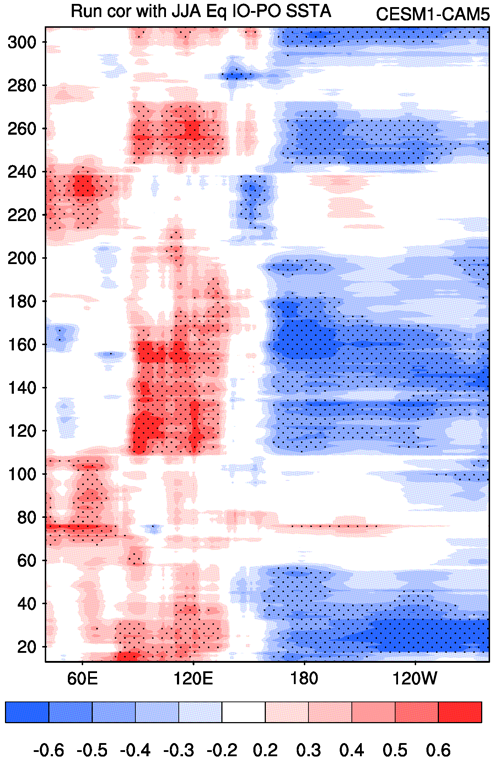The interannual variability of the western North Pacific subtropical high (WNPSH) is regulated by tropical sea surface temperature anomalies (SSTA). Previous studies reveal that the interannual variability of WNPSH is regulated by SSTAs over the tropical Indian Ocean (TIO), around maritime continent (MC), and over the equatorial central Pacific Ocean (CP). However, is the interannual relationship stable between the WNPSH and the SSTA in these three regions?
Based on the observational data and the output of a coupled model, Dr. HE Chao and Prof ZHOU Tianjun from the Institute of Atmospheric Physics investigated the robustness of the relationship between the WNPSH and the tropical SSTAs. Observational analyses on the period from 1979 to 2012 suggest a decadal change around 1993/94. Before 1993, the WNPSH in summer is mainly regulated by the SSTA over the TIO, while the contributions from the MC and the CP are negligible. In contrast, the WNPSH is significantly regulated by the SSTA over the MC and the CP after 1994 (Fig. 1). Further analyses show that the SSTA over TIO in summer originates from the decaying El Nino-Southern Oscillation (ENSO) in the previous winter, while the SSTAs over the MC and CP in summer are associated with the developing ENSO.

Fig.1 The observed running correlation coefficients of the WNPSH index with the SSTAs over TIO (black line), MC (red line) and CP (blue line) (He and Zhou, 2015)
Similar as in the observation, the relationships between the WNPSH and the tropical SSTA are unstable in the pre-industrial control simulation. In the 320-year freely coupled simulation of CESM with constant external forcing (e.g., green houses gases and aerosols), the WNPSH in summer is regulated by the SSTA in TIO in some decades but by the SSTA in MC and CP in other decades (Fig. 2). Analogs to the observed decadal change in 1993/94 can be found, suggesting the decadal shifts originate from the internal variability of the air-sea coupled system .

Fig. 2 The longitude-time profile of the correlation coefficient between the WNPSH index and the 5˚S-5˚N averaged SST in pre-industrial control simulation of CESM. (He and Zhou, 2015)
The above results indicate the unstable relation between the WNPSH and the tropical oceans. Therefore, attention should be paid on the selection of oceanic predictors in operational prediction.
Reference:
He C, Zhou T (2015) Decadal change of the connection between summer western North Pacific Subtropical High and tropical SST in the early 1990s. Atmos Sci Lett 16 (3):253-259. doi:10.1002/asl2.550
Contact: ZHOU Tianjun, zhoutj@lasg.iap.ac.cn







